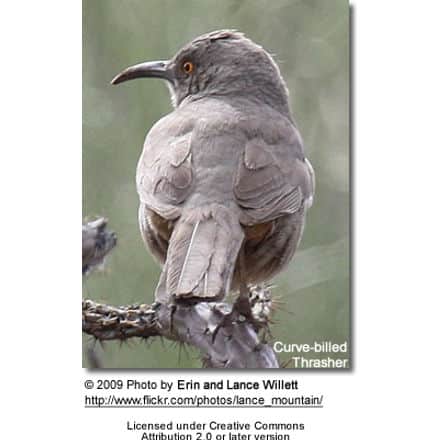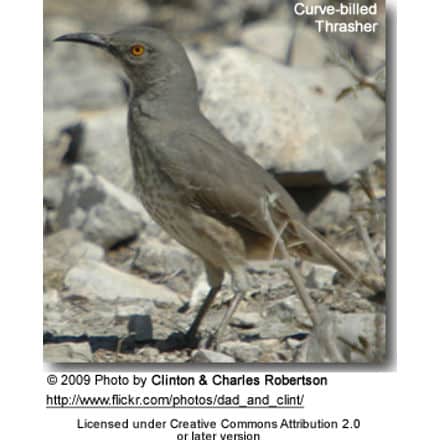Curve-billed Thrashers
The Curve-billed Thrashers (Toxostoma curvirostre) – also known as Bow-billed Thrashers, Brownsville Thrashers, or Palmer’s Thrashers – occur naturally in the Southwestern United States and Mexico.
These common birds of the arid Southwest, the Curve-billed Thrashers have successfully adapted to a wide range of habitats, which may explain why they are the most widespread of the western thrashers.
These bold and curious birds will broadcast their presents with their loud “whit-wheet” calls while flying from shrub to shrub.

Distribution / Range
Curve-billed Thrashers occur in southwestern and central Arizona (Sonoran Desert), southeastern parts of Colorado, and northeastern New Mexico through western and central Texas, ranging south to southern Mexico.
They are mostly resident (non-migratory), as long as food and nesting opportunities are readily available.
Curve-bills are common throughout the semi-deserts and deserts (however avoiding extreme deserts), as well as being found in shrubby and open brush woodland areas. They frequently visit suburban neighborhoods.
These thrashers are often observed roosting in tall trees or spiny vegetation, favoring palo verde, mesquite, and cholla cactus.
Subspecies and Ranges
- Toxostoma curvirostre curvirostre (Swainson, 1827) – Nominate Race
- Found in central and south central Mexico (south of the states of Puebla and Oaxaca).
- Toxostoma curvirostre palmeri (Coues, 1872)
- Range: Southwestern and Central Arizona south to northwestern Mexico (south to central Sonora).
- Toxostoma curvirostre insularum van Rossem, 1930
- Range: Tiburón and San Estebán Islands located in the Gulf of California off the western Sonora coast in northwestern Mexico
- Toxostoma curvirostre maculatum (Nelson, 1900)
- Range: Northwestern Mexico (southern Sonora, northern Sinaloa, and southwestern Chihuahua).
- Toxostoma curvirostre occidentale (Ridgway, 1882)
- Range: West central Mexico, to the western states of Sinaloa and Jalisco.
- Toxostoma curvirostre celsum R. T. Moore, 1941
- Range: Southern USA (from southeastern Colorado, southwestern Kansas, and extreme northwestern Oklahoma south to southeastern Arizona, New Mexico, and western Texas) and north central Mexico to the state of Zacatecas.
- Toxostoma curvirostre oberholseri Law, 1928
- Range: Southern Texas south to northeastern Mexico and the south-central state of Tamaulipas
Description
Curve-billed Thrashers generally measure 10 – 12 inches (25 – 28 cm) in length (including the long tail); have an average wingspan of 13.4 inches (34 cm) and weigh about 3 oz (85 g ). They are slender in build and have a long, curved, sickle-shaped bill for which they were named.
The plumage is overall brownish-grey, with a mottled chest. The tail is mostly dark grey, except for the white streaks on the tail tip and the darker sides. Some have narrow white wing bars. The eyes range in color from yellow to orange or even red-orange.
Gender ID: Males and females look alike.
Juveniles have yellow eyes and straighter bills.
Subspecies / Regional Differences:
Populations found in the Sonoran Desert of Arizona and northwestern Mexico (ssp. palmeri) are smaller in size and have longer tails. The eyes are yellow; the greyer chest has less defined spotting. Their wingbars are inconspicuous and the tail corners are greyish.
Those occurring in the Chihuahuan Desert of Texas and central Mexico have orange eyes, a paler chest, more contrasting spots, lighter wing bars, and white tail corners.
Similar Species Id:
- The Curve-billed Thrashers can be easily distinguished by their streaked chests. Most other thrasher species occurring in their range have plain chests.
- The Bendire’s Thrasher has a shorter and straighter bill; easily confused with juvenile Curve-billed Thrashers.
Nesting / Breeding
Pairs are monogamous, remaining together all year in a permanent territory. Breeding occurs in spring, at which time the males will be heard singing as they announce their breeding territories.
Their nests are often found in spiny shrubs, yucca, or prickly-pear – but they clearly favor the cholla cactus plant, where the nests are typically placed under the upper protective branches about 3 – 5 feet (1 – 1.5 meters) above the ground. Its thorny twigs are used to construct the loosely woven, deep cup nests. The nests are lined with grasses, rootlets, hair, feathers, down, or other fine materials.
They may build their nests on top of abandoned Cactus Wren nests or may reuse nests from previous seasons.
The female will lay 2 to 5 eggs (average 3), which are light bluish-green in color, speckled with reddish brown.
During the daytime, both parents share the incubation of the eggs; and at night this duty is mostly performed by the female.
The eggs are incubated for about 12 – 15 days to hatching. Both parents feed and protect the nestlings, which will leave the nest about 14 – 18 days after hatching.
Pairs usually raise two broods a year – if conditions are favorable up to three.
Diet / Feeding
The Curve-billed Thrashers mostly feed on various insects and their larvae (beetles, ants, wasps, etc.), as well as spiders, centipedes, snails, and sowbugs, and – to a lesser extent – on seeds and the fruits of various cacti (prickly-pear and saguaro) and berries.
They mostly forage on the ground, poking and probing under dead leaves and other plant litter, turning over small rocks, and digging holes into the soil with their long, down-curved bill. In hard dirt, they pound straight downward with heavy blows of the bill.
Alternate (Global) Names
Chinese: ???? … Czech: Drozdec krivozobý, drozdec skvrnitoprsý … Danish: Krumnæbbet Røddrossel … Dutch: Krombekspotlijster … Finnish: Lavertajasirppimatkija … French: Moqueur à bec courbe … German: Krummschnabel-Spottdrossel … Italian: Mimo beccocurvo … Japanese: Maruhashitsugumimodoki … Norwegian: Kaktusspottefugl … Polish: przedrzezniacz krzywodzioby, przedrze?niacz krzywodzioby … Russian: ????????? ??????????? ??????????? … Slovak: Drozdec krivozobý … Spanish: Cuitlacoche común, Cuitlacoche de Pico Curvo, Cuitlacoche Pico Curvo, Cuitlacoche Piquicurvo … Swedish: Bågnäbbad härmtrast






